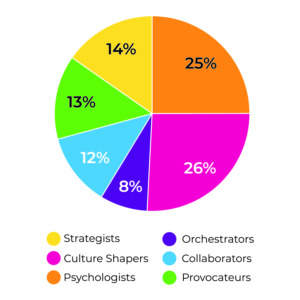Agencies have one of the hardest jobs in business today. There’s the obvious of managing client accounts, but also uniquely building your own brand, not to mention pipeline, quick-turning proposals, staying on top of ever-expanding technology, and even your own employee experience and agency culture. But while the list keeps growing, budgets and resources keep shrinking.
We’re at a tipping point, where the skills of an agency owner and your staff are more about the ability to find opportunities, solve problems, drive change, and deliver growth than just tactical execution. Clients expect agencies to become more strategic in their partnerships. Unless you’re perfectly fine always competing on fees, it’s time to look at the bigger ecosystem of how to collaborate and introduce ideas that help your clients’ (and your own) business succeed, while expanding our influence.
The Innovation Crisis
According to McKinsey, 84% of executives say innovation is critical for their business, yet only 6% are satisfied with their company’s innovation performance. While the past decade has brought an undeniable focus on technology and processes when it comes to innovation, conversations grossly lack the third element that the savvy 6% of executives understand—people.
The demand on marketers for critical thinking and more creative work has spiked, but most are at a loss at what to do. So where do they turn? Their agency.
Corporate leaders often look at creativity and innovative thinking as a value to post on a wall, flexible ways to work, or a physical attribute of office space. A key indicator of the likelihood of organizational success is effective collaboration. It’s a skill that can and should be taught, yet few internal to a brand are capable of doing it.
Again, where do they turn? Their agency.
Building Innovative Teams
As we struggle with the balance of art and science in business today, it’s time to tap into the legions of employees who are ready, willing, and able to collaborate toward the growth of their organization through innovative ideas. We’re in the midst of a shift in the ownership of ideas—from the few to the many.
As marketers, we’re tackling problems big and small, and reinventing our role in business today. By empowering your agency and teams to lead the contribution of ideas, you show that not only do marketers play a necessary role in shaping business, we have an obligation to do so.
Not every innovator looks the same, nor should they. Companies need a mix of archetypes, not just innovation-specific job roles or titles, to solve problems. Everyone has strengths and areas in which they do their best work—what I call natural genius.
Following are the six archetypes of innovators that make up the most successful teams in the most innovative companies, regardless of size, industry, or location. These archetypes are based on research from successful innovation teams around the world, combined with my own in-depth study and experience in working with teams that range from startups to Fortune 50 brands.

- Strategists.
Natural Genius: Plan and execute.
As the name implies, this group loves to create strategy and get things done. They know and understand the bigger business blueprint and are adept at shepherding work through the process and out the door. But, while they like to have concrete plans and measure and report progress, they can get so caught up in executing the big picture that they lose sight of how to bring others along for the ride.

- Culture Shapers.
Natural Genius: Communicate change.
Culture Shapers architect the brand and oversee its expression. This archetype brings the rise of the storytellers. They use it to activate and inspire trust, participation, and courage among their fellow team members. However, Culture Shapers can get so caught up in nailing the execution of a story that they lose sight of the most important element—people.

- Psychologists.
Natural Genius: Foster empathy.
By smashing the traditional perspective of a highly rational approach to solving problems, Psychologists understand unstructured innovation. This is where empathy in business comes into play: understanding the evolving role of trust in all business relationships, whether it’s among colleagues or between the firm and its clients. But they can get too hung up on how ideas make people feel or get mired in politics.

- Orchestrators.
Natural Genius: Lead fearlessly.
Orchestrators naturally choreograph processes and keep things humming. They establish relationships early and don’t shy from difficult conversations. They know how to maneuver the political steppingstones in every corner of the business. However, their fearless leadership can give them a reputation as being a lone wolf, which can make big programs feel like piecemeal projects.

- Collaborators.
Natural Genius: Integrate.
Creativity and innovation rely on partnerships and socialization. Collaborators love to get involved, help improve ideas, then champion them. They understand how to capture people’s attention to excavate blind spots and nurture relationships. But their focus on bringing everyone together can mean that ideas get flat over time.

- Provocateurs.
Natural Genius: Challenge the status quo.
These nonconformists question long-held assumptions and generate highly original ideas. As creative disrupters, they lead the way in coming up with new ideas to create transformation within all areas of the business. However, their unconventional approach to problem-solving can rub others the wrong way.
Impact of Archetypes on Teams
The different archetypes impact their other team members—including how they perceive feedback and suggestions, as well as how they may value each other’s contributions. When strengths are at odds, the work suffers.

A cumulative view of team archetype assessments to date. Courtesy Carla Johnson.
For example, in looking at the chart above, based on responses from thousands of people worldwide who’ve assessed the archetypes of their team members, you’ll see an interesting story unfolding.
More than half (51%) identify as either Culture Shapers or Psychologists, which makes sense in the highly customer-focused world of business innovation. Strategists are also an easily recognized function, and we give credit to the envelope-pushing Provocateurs.
While marketers may say they’re equipped to drive change and transform business, the chart above shows otherwise. The natural Collaborators—those who innately know how to reach across silos and integrate with IT, finance, HR—are in short supply. However, the biggest dearth of natural talent shows up with Orchestrators—the people willing to have difficult conversations necessary for teams to move innovative ideas forward. Avoiding these talks doesn’t keep the peace; it holds people back, hurts the credibility of innovation, and keeps teams from realizing their highest potential.
Creating Whole-Brain Teams
You may be wondering if you’re going to have to hand out a bevy of pink slips so you can get your dream team in place. Relax, it’s much easier than that.
First, determine your own innovation archetype by taking my free assessment. Understanding how you work and bring new ideas to the table will give you context for how you interact with those in your agency, as well as with your clients.
Next, have your team members and even clients take the assessment. This lets you audit the makeup of your group and get a better understanding of where—and why—conflicts likely occur. For example, if your group is heavily weighted toward Psychologists and Collaborators, you’ll have insights on why everyone likes each other but might struggle to come up with exciting ideas or manage the barriers to executing them.
The exercise shows you where you need to shore up your team. This could be with input from people in other parts of your agency who have the archetypes you lack, through new hires, or with a different way of collaborating with clients.
If you’re looking to bring greater innovation to your agency, begin by reverse engineering at the individual level. Then, look at how you build your teams outside of job titles and department names. Becoming a more cohesive, innovative team doesn’t have to be overwhelming. One degree of change in your perspective on new ideas and contributors to them can make a 180-degree change in the quality and efficiency of your output.
The shift from focusing solely on roles to taking a broader view of archetypes will help you quickly develop greater alignment across your teams. And alignment is how you turn an ordinary team into an extraordinary one. Ultimately, this will lead to the goal of true innovation for your agency and your work.






